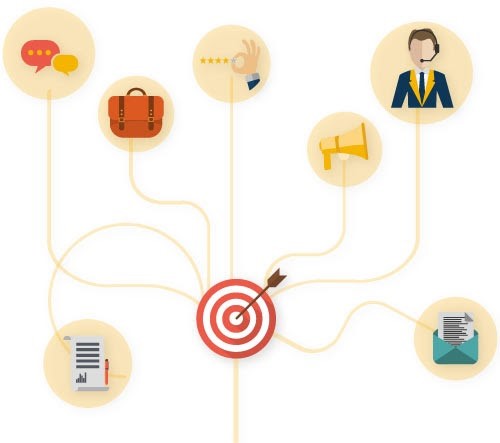
E-commerce signifies doing business (sale or purchase of the transactions) over the internet. Ecommerce marketing means promoting one’s business over the internet through digital marketing tactics and social media posts, and creating brand awareness of one’s online store.
Why is e-commerce interesting?

E-commerce business enables organizations to reach more clients than traditional retail. With such countless individuals making their buys on the internet, it is the fastest developing retail market.
E-commerce marketing strategies to grow your sales
1. Using referral program
When an old customer promotes their business to a new customer using word of mouth, it’s called referral marketing. They are the most trusted form of e-commerce marketing of a business’s product and services, because happy customers do them. A reference is a compliment, and possibly the most trusted approach to get your business before your prospect. And the best way to get referrals is to use a referral program. A referral program is a process by which you reward customers for spreading good about your product and service. A reward can be coupons, discounts, extra points.
Want to increase conversion using a referral strategy? Set up a referral campaign to boost sales and brand awareness. Use the Invite referral program to create social buzz and drive new referral traffic to your product.
2. SEO for e-commerce websites
SEO is a procedure to get more traffic to your online business webpage by expanding your natural or unpaid rankings on web indexes. It helps web marketers rank higher in search engine results. A well-planned and advanced site with top-notch content will rank better in web indexes like Google, expanding your store and driving traffic.
All in all, SEO for internet businesses focuses on optimizing your website, which makes it easier to get leads and conversions.
3. Email marketing
In email marketing, you send business messages on mailing sites to your email subscribers — contacts who have joined your email list and allowed express to get email communications from you. It is a market automation software that helps make meaningful connections and grow your business.
Besides automated emails, newsletters can also tell subscribers about discounts, new offers, upcoming products, and purchase incentives. Email marketing is used to inform, drive deals, and build a community around your brand. Present-day email marketing has moved away from one size emailing and, on second thought, centers around segmentation and personalization.
4. Social Media marketing

Everybody is on Facebook, Instagram, and Twitter each day, and your web-based business brand should be as well. By turning an e-commerce business into social media marketing, you can increase your followers, engage with current clients, and tweak advertisements to clients depending on their interests.
Social Media Marketing includes postings and updates on your brand’s social media page, so clients can connect with your brand in their news feed. Paid marketing media includes creating customized picture or video advertisements, and paying to elevate them to a particular crowd dependent on their interest, demographics, and shopping behavior. Both organic and paid social media marketing creates and increases brand awareness, resulting in more leads and conversions.
5. Affiliate marketing

It’s the act of recommending an organization’s product or service to possible clients, creating a deal and acquiring a commission on each sale. The affiliate marketing process includes four people: the affiliate website, the affiliate organization, the advertiser (buyer) and the purchaser. Organizations are more often recognizing the advantages of affiliate marketing in this e-commerce era.
It allows organizations to adequately advertise an item with a low spending plan, low effort, time, and minimum risk, while ensuring an exceptional yield on your investment, increased brand awareness, and business development.
Struggling areas for e-commerce business
Beginning an e-Store is just as simple as a snap. However, the troublesome aspect starts solely after you have begun. You need to put resources into a store plan, design, and basic materials to begin. It isn’t as straightforward as simply beginning a store and selling. Improvement of e-Commerce organizations involves somewhat more than selling. It requires clients and engaging in them; it requires smoothing out the various cycles to fruitful order satisfaction.
Some areas where it requires effort are –
- For an e-commerce website, the major area that concerns us is customer’s data getting leaked or security breaches.
- Requirement of little technical knowledge. A layperson will find it difficult to understand the strategies and tricks of e-commerce marketing.
- In traditional marketing, the seller tends to meet buyers and talk in person, gaining buyer trust easily. In e-commerce marketing, you will gain visitors to run around your website, but converting them and gaining their trust is a tough part.
- The limitation of marketing law is also one of the biggest challenges, which does not keep pace with digital technologies reforming how we interface.
Use of conversion rate optimization software for e-commerce marketing.
The main objective of e-commerce marketing is to increase website traffic and convert it into visitors. And this is what conversion optimization software such as A/B testing, Heatmap, Segmentation, User session replay, and Cohort does. These AI and machine learning software will track and analyze user behavior and evaluate your company’s progress, changing marketing campaigns according to it and driving real results.
Ecommerce marketing tips
- Influence people to say that email marketing is more than giving attractive discounts or part of a sale. Talk to your subscribers, and tell them stories. Be real and connect with them like a family.
- Invest in research and implementation. That is the only way to combat the changing environment in the e-commerce world, which is unpredictable and ever-changing.
- Use market automation software like a chatbot, sms and email, attribution tracking and many more as much as possible.
- Creating a web-based marketing plan might seem daunting. However, the success of ecommerce marketing procedures and channels that can help drive traffic online is huge.
- Each internet business store should write consistently for a blog to connect with clients and rank better in search engines. If you’re now making Content, consider effectively highlighting your blog on each of your online stores.
- Optimize your product pages and mobile, because more than half of all online shopping happens on mobile devices. So design your website or social media accounts from start to finish, keeping in mind your mobile visitors.
- Reward your loyal customers by encouraging and promoting referral programs, offering attractive discounts for gaining customer loyalty, as customer loyalty improves every business metric and improves client retention. Your loyalty program needs to be robust, and you can implement it easily using the referrals program.
Wrapping up.
The discussion is endless. Now you have enough knowledge of e-commerce marketing, its strategies and tactics, some universal tips and limitations. To decide which strategy to adopt depends on the structure, nature and type of the business. But one thing which should be kept in mind is that content should be actual to get a genuine impact and actual desired revenue.
 Shivani is a content writer at InviteReferrals & NotifyVisitors. She writes SEO articles, blogs, and guest posts for businesses to improve website ranking on SERP. She follows a balanced approach to the quality of content and its marketing. She loves to do creativity, although she had an English major in her graduation.
Shivani is a content writer at InviteReferrals & NotifyVisitors. She writes SEO articles, blogs, and guest posts for businesses to improve website ranking on SERP. She follows a balanced approach to the quality of content and its marketing. She loves to do creativity, although she had an English major in her graduation.